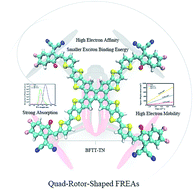Quad-rotor-shaped non-fullerene electron acceptor materials with potential to enhance the photoelectric performance of organic solar cells
Abstract
In recent years, non-fullerene acceptors, especially fused-ring electron acceptors (FREAs), have been successfully applied to develop high-performance bulk-heterojunction organic solar cells (OSCs). FREAs are typically composed of two strongly electron-withdrawing end groups connected by a planar fused-ring core. Through variation of the fused-ring core and electron-withdrawing end groups, OSCs based on these materials exhibit a higher power conversion efficiency than those based on fullerenes, and the highest power conversion efficiency exceeds 14%. However, the optimum thickness of the active layer of FREAs remains limited to ∼100 nm, which is mainly due to the low electron mobility of traditional FREAs. Therefore, developing new FREAs with higher electron mobility is of great significance. Here, we proposed two novel FREAs, namely, BFTT-N and BFTT-TN. These FREAs consist of four strongly electron-withdrawing end groups linked by a two-dimensional fused-ring core, forming a structure similar to a quad-rotor helicopter. These two FREAs not only exhibit higher electron mobility than the widely used non-fullerene acceptor ITIC but also have lower frontier molecular orbital energy levels, greater electron affinity, higher absorption coefficients and smaller exciton binding energies. Compared with that of ITIC, the absorption spectrum of BFTT-TN is red shifted approximately 100 nm, and its integrated intensity is 2.4 times that of ITIC. These numbers indicate that BFTT-TN features strong absorption in the visible and near-infrared region and produces more excitons. Simultaneously, the exciton binding energy of BFTT-TN (1.47 eV) is smaller than that of ITIC (2.04 eV), which can facilitate the separation of excitons into free charges. In addition, the electron mobility of BFTT-TN (5.32 × 10−3 cm2 V−1 s−1) is 6.5 times that of ITIC (8.20 × 10−4 cm2 V−1 s−1), which can accelerate the transmission of electrons to improve the short-circuit current. All these results imply that the quad-rotor-shaped FREAs are more suitable as electron acceptors for high-performance OSCs. The quad-rotor-shaped FREAs are expected to be an important candidate for the development of next-generation FREAs for high-performance OSCs.



 Please wait while we load your content...
Please wait while we load your content...